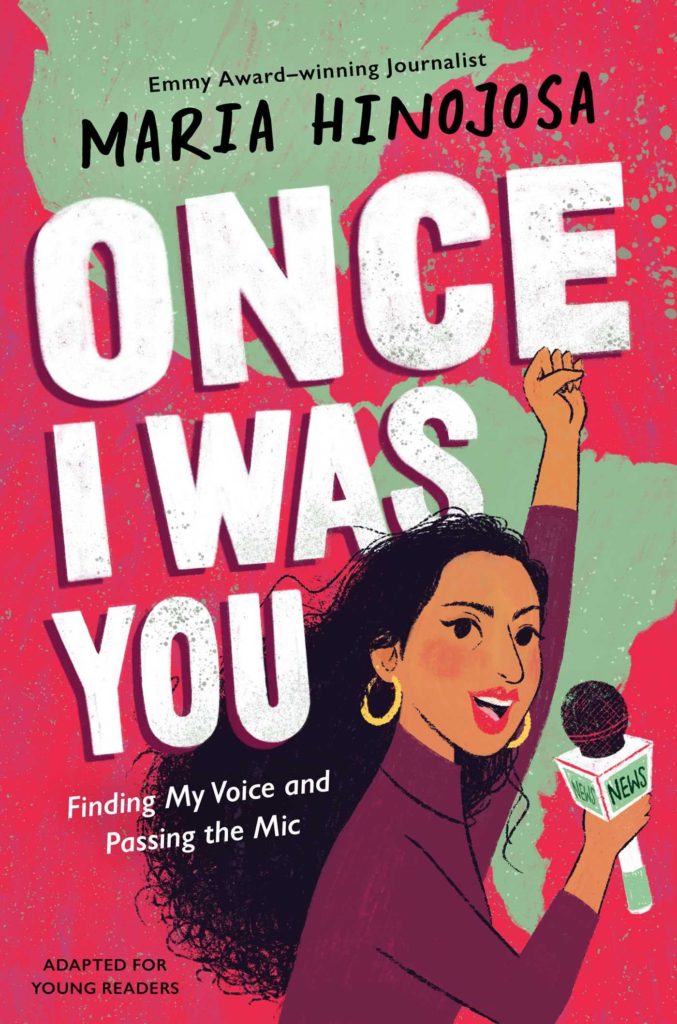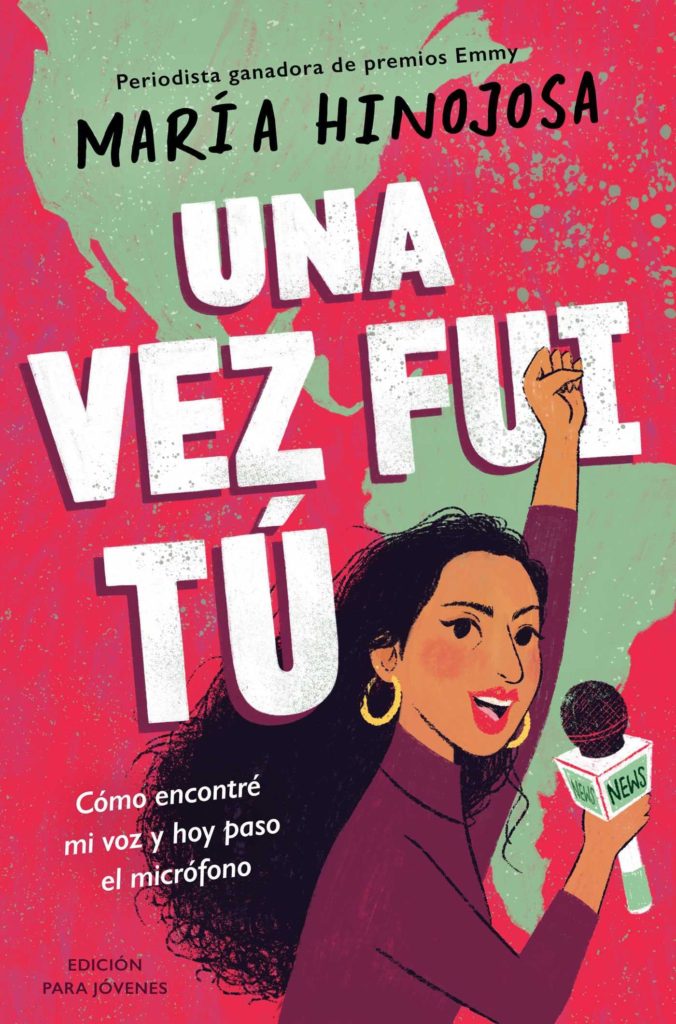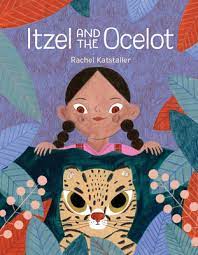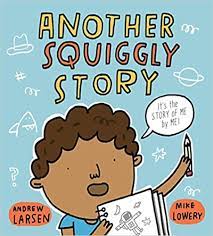So many children’s books address the theme of feeling like one doesn’t fit in and having the courage to be oneself, and that is fitting, as it’s a struggle we all face at one time or another. This one has the added benefit of addressing this common theme through the experiences of a group often underrepresented in our libraries. It tells of a girl who is so excited to be heading to the pool with her mom in her new burkini, feeling like “a dainty seahorse, or a splendid pineapplefish,” ready to enjoy a day as a mermaid girl. Her joy vanishes when other swimmers point out that her swimsuit doesn’t look like a “real” swimsuit, and question whether she’ll even be able to swim in it. Her mother reminds her of the brave mermaid girls who have come before her and the many more that will come later, and that to stand out is to be full of the things that make you you. With a boost of courage, she joins in and her friends see that she can do all the things they can do, until they want to be mermaid girls, too (even Sam).
Category Archives: Highly Recommend
Teo’s Tutu
I like it. It celebrates being yourself, while recognizing that it’s not always easy to do so. It tells of a young boy who loves to dance. He’s excited and nervous on his first day of ballet lessons, knowing it will be different than the cumbia or bhangra dances he enjoys at home with his family, but inspired by memories of seeing a Swan Lake performance. When another boy in the class asks why he’s wearing a tutu, he simply answers, “Because it’s pretty.” I like that the story shows both boys and girls in the ballet class. I like that the parents and dance teacher never once make any kind of issue about Teo’s tutu, but are only ever positively encouraging Teo to enjoy himself, and yet when it comes time for Teo to choose a costume for the big performance, it only takes feeling the eyes of the other students on him to make him feel pressured to choose the shirt and pants. Even when peer pressure is subtle it can be powerful. In the end, Teo chooses the costume in which he feels most comfortable and thoroughly enjoys a successful performance before his biggest fans.
Bad Things Happen Here by Rebecca Barrow
Readers who like Karen McManus will love this new book by Rebecca Barrow. Set on an old-money island, Luca and her peers believe the place to be cursed. Too many of Parris Island’s young girls have gone missing and turned up dead; including Luca’s best friend and sister. As Luca pursues the clues surrounding the disappearance of the girls, she quickly becomes surrounded by her own dangers. This is a thrill ride from the start; lots of clues to be had in this fast paced mystery. Just when we think things are working themselves out; there’s always more to uncover. Highly Recommend.

Dressing the Stars: The Story of Movie Costume Designer Edith Head by Jeanne Walker Harvey
This picture book about legendary Hollywood costume designer Edith Head is a story stressing the themes of determination and persistence. As a young girl growing up in the deserts of Nevada, Edith made costumes for her pets and dolls. While still school age she discovered the power of costumes to create characters for her human friends. After moving to Los Angeles, California, one of her first jobs in Hollywood movies was to create costumes for animals in films. She could imagine and construct costumes, but couldn’t sketch well enough to be taken seriously as a designer.
Edith worked hard at learning to illustrate and eventually earned her way to dressing some of the most famous actresses in popular motion pictures of the last century. Fun illustrations, suggesting the bits and scraps of fabric from which Edith made her earliest pet and doll costumes, decorate the book with lots to enjoy. The book ends by noting the recognition of Ms. Head’s work in film with her many Academy Award nominations and wight wins.
The Author’s Note after the story is an excellent addition for older readers sharing the book with younger students.

Rick: the Rock of Room 214
Written by Julie Falatko, Illustrated by Ruth Chan
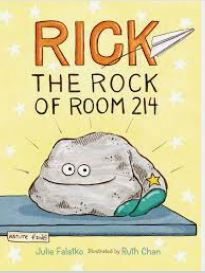
Rick is a rock who lives on a shelf with other items found outdoors by students that learn in room 214. Rick finds that the students seem to have many adventures and he wants them too. He wants to be the rock that does more that sit. He wants to have adventures like going through a volcano, falling off cliffs and posing on a majestic mountain. One day, he falls into a backpack and goes outside looking for new things to do. What he finds are many rocks who are quiet, and no longer want adventures in their lives. Will Rick find what he wants or will he end up being a quiet rock sitting in a field? This is a very cute book that wonderfully explains how one can find adventure and enjoy life wherever one is, even if it is just sitting on a shelf in a classroom. I would highly recommend this one!
Once I Was You: Finding my Voice and Passing the Mic (adapted for Young Readers)
by Maria Hinofosa
This book is a powerful story that discusses the challenges of an immigrant Latina woman in the United States. Maria Hinojosa tells her story about the challenges of being an immigrant to the United States, arriving in this country in 1962. This book not only tells the story of Hinojosa finding herself as a Latina woman but also tells the story of finding out who she is, as a person. The story of Hinojosa’s life is compelling and draws you back time after time. The story of her feelings pull at your own self conscience and make you feel as if you know the author personally. It included photographs of the author at various young ages before she became well-known in her career in journalism. I enjoyed how the book connected with my own feelings even if our experiences were different. I did not like how there was some Spanish in the book without translation, but it was a very small amount and did not take away from the story. Overall, I would highly recommend this book and give it a 5 out of 5 stars. [This review written by a Komachin staff member , Erica C. ]
This book is also available in a Spanish edition. (ISBN: 1665920882)
Grounded for All Eternity
by Darcy Marks
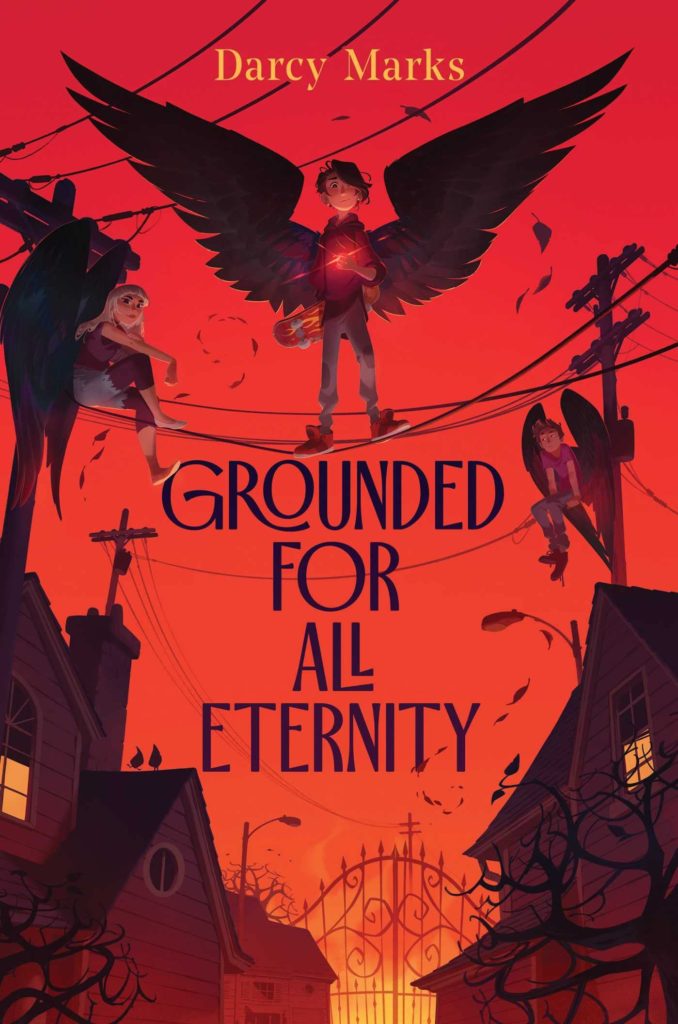
Mal and his friends are just regular teens, except that their quiet suburban neighborhood is located in an unusual place – Hell. They are currently under lock down during their last vacation together for a while because of an escaped prisoner from the 8th circle of… Hell. The friends end up “falling” into another dimension – Earth – and realize they have to help bring the escaped prisoner home if they want to get back to their regular lives. This funny story was full of adventure and turned the stereotypical ideas of Hell=bad/Heaven=good a bit on its head. As it turns out, BOTH do the world a pretty important service & by working together, they just might accomplish their goals more efficiently. Similar to the recent popularity of mythology books by Rick Riordan and others, this tale melds a bit of the horror genre with the mythology of the hereafter. Much of the story takes place on Halloween in Salem, Massachusetts (& in Hell), so it’s also a perfect October read! There is a slight hint of a possible lgbtq romantic relationship in Mal’s future, but it’s very subtle. Mal has romantic interest in both a girl and a boy in the book – neither of which really develops in the story until a romantic letter he writes at the very end to one of his interests. I thoroughly enjoyed this book and am sure my students will eat it up!
Tin Man
by Justin Madson
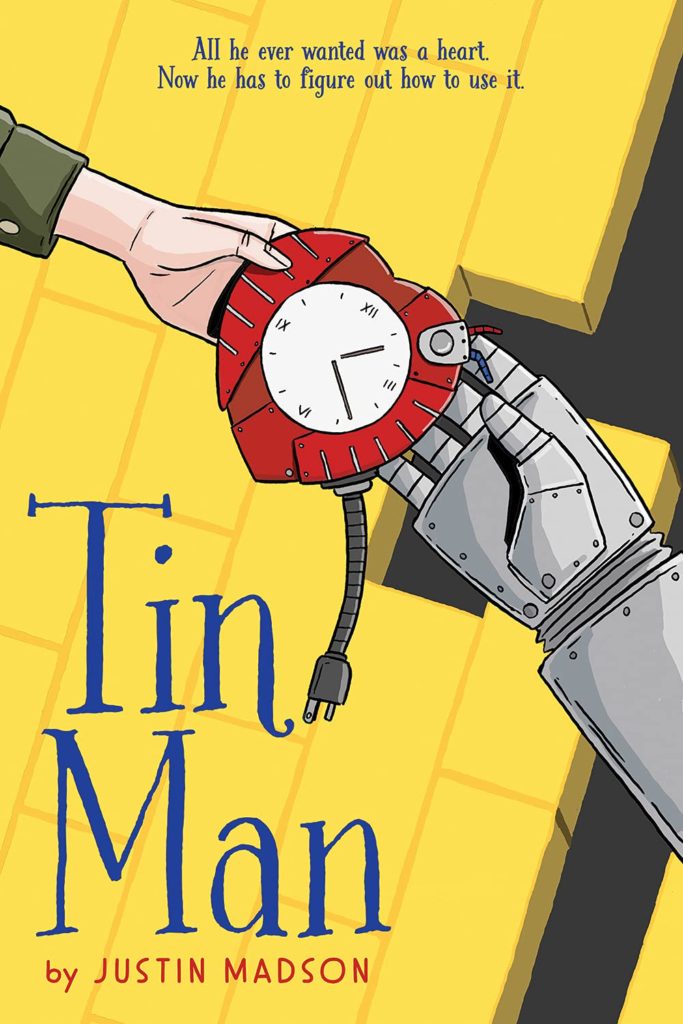
Fenn, a lonely boy, meets Campbell, the tin man in a junkyard while looking for spare parts for the rocket ship he’s building in his garage and they instantly become friends. Fenn also finds a metal clock/heart part that he assumes belongs to the tin man & hands it to him. So begins the twisted, modernized tale of the Wizard of Oz, complete with a yellow brick road, a tornado, and a wizard of sorts. Fenn’s sister, his once-helper of the rocket, is struggling with her own problems – the loss of their grandmother, a jerk of a boyfriend, and flagging hopes and dreams. She, too, finds help from the tin man struggling with his own problems and broken heart. Even without knowing the original story of The Wizard of Oz, I think modern readers will enjoy this graphic novel. The art work is done in bold colors and subtle facial expressions, but add to the poignancy and rough times all the characters are striving to get through. I enjoyed all the little “Easter eggs” scattered throughout the story that refer back to the original story. In one scene you see two women talking. One is clearly Glinda & the other, clad in black & white striped tights & red shoes, is a nod to the Wicked Witch of the West. A lion appears on a movie poster and a sweater. The Flying Monkey taco truck. Even the town name forms the initials O.Z. This is a clever graphic novel that has much to offer. I think readers will enjoy it.
Hana Hsu and the Ghost Crab Nation
by Sylvia Liu
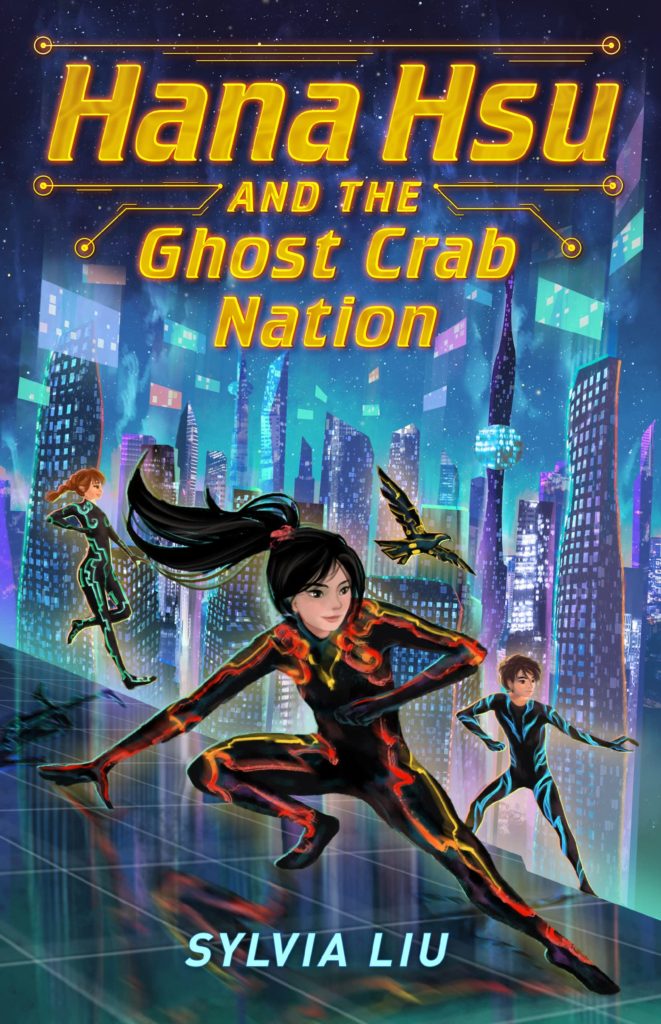
I really enjoyed this action-packed, futuristic story of a plucky twelve year old heroine whose curiosity and determination save her and her classmates from becoming manipulated by adults who should have been protecting and training them. The story shows Hana and her friends in a recently accelerated program to learn how to use a technology that will mesh their minds with the internet and each other. She quickly realizes that something is not right with the program and begins to investigate. She does this while grieving her father and the splintering, distant feelings of her immediate family. Readers who love technology or video games will enjoy the action scenes in the virtual world as the students train with their new tools. I liked that Hana also loves OLD technology, particularly animatronics that she builds from scraps in the junkyard. The pacing of the story is solid and the characters are all multi-ethnic. Even the cover draws you in. I think this title will be a hit with middle school readers who enjoy a fast-paced novel of intrigue and action.
Noodle and the No Bones Day
Written by Jonathan Graziano, Illustrated by Dan Tavis
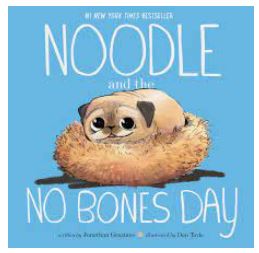
What a wonderfully adorable book about a pug and his person. This tale emphasizes that it is okay to have an “off day” every once in a while. Noodle and his person, Jonathan – the author, have busy and adventuresome days every day but when Noodle is feeling under the weather, Jonathan becomes concerned. Soon he realizes that there are days where one must just take the time to relax and be content to just be. A highly recommended tale for elementary students that really explains that it’s okay to have a “no bones” day.
Little Red and the Big Bad Editor
The Big Bad Wolf Editor actually saves Little Red from being eaten fives times in this retelling of Little Red Riding Hood. Who could have guessed the wolf, turned editor, cared more about the rules of good composition than in eating his prey? When Red runs into the Wolf on her way to Grandma’s house with her basket of goodies, topped off with a thank-you note, the editor in the wolf wins over time and time again. Wolf is compelled to correct Red’s composition mistakes: no finger spaces between words, no capital letter at the beginning of each sentence, and no greeting salutation or signature at the end of the note.
Combine that with the ‘cool as a cucumber’ similes, onomatopoeia, and colorful verbs the wolf with his pencil behind his ear are doomed to not enjoy a human meal today. Who would have guessed the IMPORTANCE of a great thank-you note!
Little Red and the Big Bad Wolf Editor
School of Phantoms
This book is a solid addition to the current craze for scary books for younger children. Former elementary art teacher Kory Merritt does a great job of tapping into some of our deepest fears and weaving them into the plot and his illustrations. Let’s review. The fear of disappearing and no one noticing you are gone (not even your parents)? Check! Your fear of that creepy house on the edge of town that just doesn’t seem right? Check! The fear of scary looking snowmen getting closer whenever you aren’t watching? Check! Unidentifiable, weird creatures coming out of the walls? Check! A dark basement full of alienesque creatures? Check!
The format is a true hybrid, seamlessly going back and forth between sections with a half page of text with one large picture to a graphic novel. In lesser hands this style can be distracting, but Merrit uses it to build energy and suspense as well as signal moves between different locations and plot lines. The main character Kat is using her phone to film a documentary on the strange goings on in their small town. The result has a Blair Witch Project meets Buffy the Vampire Slayer vibe.
The characters feel like real people and are relatable. From the distracted school principal to the cool science teacher to the janitor who seems a bit out there, each person adds a layer to the story. If you pay close attention to the janitor’s dialog, you will recognize nods to some films like The Princess Bride.
The strongest part is the illustrations. From the students gathered in the cafeteria to an all out otherworldly invasion, the pictures are powerful. They are what keep you turning pages. The story however goes deeper than what you might expect. This could be a great way to engage reluctant readers of novels to dig deeper and learn about plot devices, character development, or satisfying endings,to name a few. Merritt cleverly builds his narrative across the entire story. While there is a resolution at the end, you also realize the story is not over yet. You are wondering about what will happen next.
This is the second of three books planned for the series. I hope Kory Merritt continues to offer kids great adventures.
Stick and Stone: Best Friends Forever!
This picture book is a rollicking, rhyming celebration of friendship and what being a family means. Ostensibly, Stick and Stone are off looking for Stick’s family tree, but when the adventure turns from fun to frightening to hopeless Stone tells Stick that he is his family and Stick agrees.
The delightful end papers have stick sprouting leaves of many different trees, which tie in with an illustration in the book. The humor around a stick looking for his family tree, which literally is a tree, remains funny throughout. The sunny illustrations reflect the energy between the two friends. The palette temporarily becomes darker when things get tense, but returns to vibrant color after help is received from another friend. Emerging readers will be successful with the repetition and simplicity of words and the short sentence length.
This book might be an especially good fit for young children who are adopted or, for whatever reason, are unable to make a connection with their heritage or ancestry.
The Care and Keeping of Freddy
The only thing I would change about this book is the title. I kept looking for a connection, but Freddy remained a minor character.
This story does a fabulous job of showing what can happen to kids when they are let down by adults who are supposed to care for them. Georgia’s mom leaves suddenly the same day she buys Freddy, a bearded dragon, for Georgia. She returns with a new husband and a baby over a year and a half later. Georgia is thrilled. . .or is she? Georgia’s best friend and aspiring writer, Maria has parents who happily retreat to the camper behind the garage all summer leaving her Abuela and six kids to pretty much fend for themselves. New kid in town Roland (Roly) is in foster care with the very religious Farley family because his dad is incarcerated and his mom was declared “unfit”.
These eleven and twelve year old characters come to life as the reader experiences their friendship, struggles, and adventures. Georgia’s relationship with her clearly depressed but doing-his-very-best-for-his-daughter father is especially poignant. We see the emotional roller coaster and hurt Georgia and Roly endure. Georgia is determined to get her parents back together, but then she starts noticing the not-so-great things about her mom that she had forgotten about when her mom abandoned her.
There are no easy answers for anyone in this story, but there is hard won wisdom. It is an intense, emotional ride, but well worth the trip.
Jazz for Lunch!
This book is a visual celebration of Jazz. Written in the rhyme, you can feel the music in the rhythm of the words as they connect the food prep of Auntie Nina and her young nephew to the sounds of different instruments. Each page has a few words in large, colorful fonts that jump off the page. The vivid illustrations match the excitement of the music. There are also nods to the legends of Jazz including Ella Fitzgerald, John Coltrane and Thelonius Monk. The end papers have paragraph bios of the musicians mentioned in the text. This book would work well to introduce children to the joy of experiencing Jazz.
There’s a Ghost in This House
Every day students ask me for scary books. Here is one that is more Casper the Friendly Ghost than Elm Street. A girl moves from room to room in her 18th century house looking for ghosts that she has heard live there, but she never sees one. The fun is when you turn the translucent page that overlays where she is looking to reveal the playful ghosts that are having fun hiding from her. Each page has one or two short sentences. This book appeals to young children who enjoy the surprise factor in “lift the flap” books. The illustrations of the rooms are done in brown and cream contrasting the girl who has bright yellow and green. This palette also allows the white ghosts to appear clearly. One consideration, is the translucent ghost pages are less durable that the paper ones. Readers will also want to flip these back and forth several times to make the ghosts appear and disappear, so they will have more use. This is a delightful, engaging book that is a perfect fit for early elementary students.
If You Were an Elephant
Young listeners and early readers can learn all about African bush elephants in this gentle book about our largest mammal. Hints of African patterns and soft sun-bleached colors add to the sweet, but factual story of elephant life. The book also included an “Amazing Facts about Elephants” page at the end that will have readers, young and old, wanting to share what they have learned about the lives of African elephants.
Elephants Don’t Like Ants! (and Other Amazing Facts)
Kids who have even a slight interest in elephants will enjoy this informative book. The first couple of chapters explain the differences between elephants in Africa and Asia, with photos and cartoon illustrations. The book also explains the special characteristics of elephants – did you know that their trunks have 40,016 muscles and can smell water up to 12 miles away?
Next, the book emphasizes how special elephants are – how they can remember things for many years, how attached they are to their family groups, etc.
At the end, readers are asked a few questions, to help them assimilate what they’ve read.
There’s a Lion in the Forest
This is a hilarious story of mistaken identity based in the Atlantic Forest of Brazil. A toucan hears a growl and is sure it must be a lion. Capybara reminds toucan there aren’t any lions in South America. As the growls continue, they see a long lion’s tail. Then the coati sees a thick and menacing mane. Finally the creature emerges to convince the animals that there really is a lion in the forest; golden lion tamarin.
The rolicking repetative text and colorful illustrations make this a great choice for story time.
The Fossil Whisperer by Helaine Becker and Sandra Dumais
This picture book biography of Wendy Sloboda shows how nurturing her curious and adventurous nature as a child helped her develop the skills she needed to become a world renowned fossil hunter. While always fascinated in exploring and documenting the world around her, it was during a field trip when she was 12 that she found her first fossil and was hooked. Wendy is now recognized as one of the preeminent fossil hunters alive today. She is most well known for the discovery of a new species of ceratopsian, the Wendiceratops. Over the course of her career, she discovered more than 3000 fossils.
Wendy Slobada’s energy is captured in the engaging illustrations. Endpapers include more information about Wendy, fossil hunting, Alberta’s bone beds, and the Wendiceratops.
The story of a female fossil hunter with dreadlocks and a tattoo reminds all students build on their strengths and interests – be themselves as they follow their dreams. A great choice for dinosaur lovers and to promote women in STEM.
Zachary Ying and the Dragon Emperor
by Xiran Jay Zhao
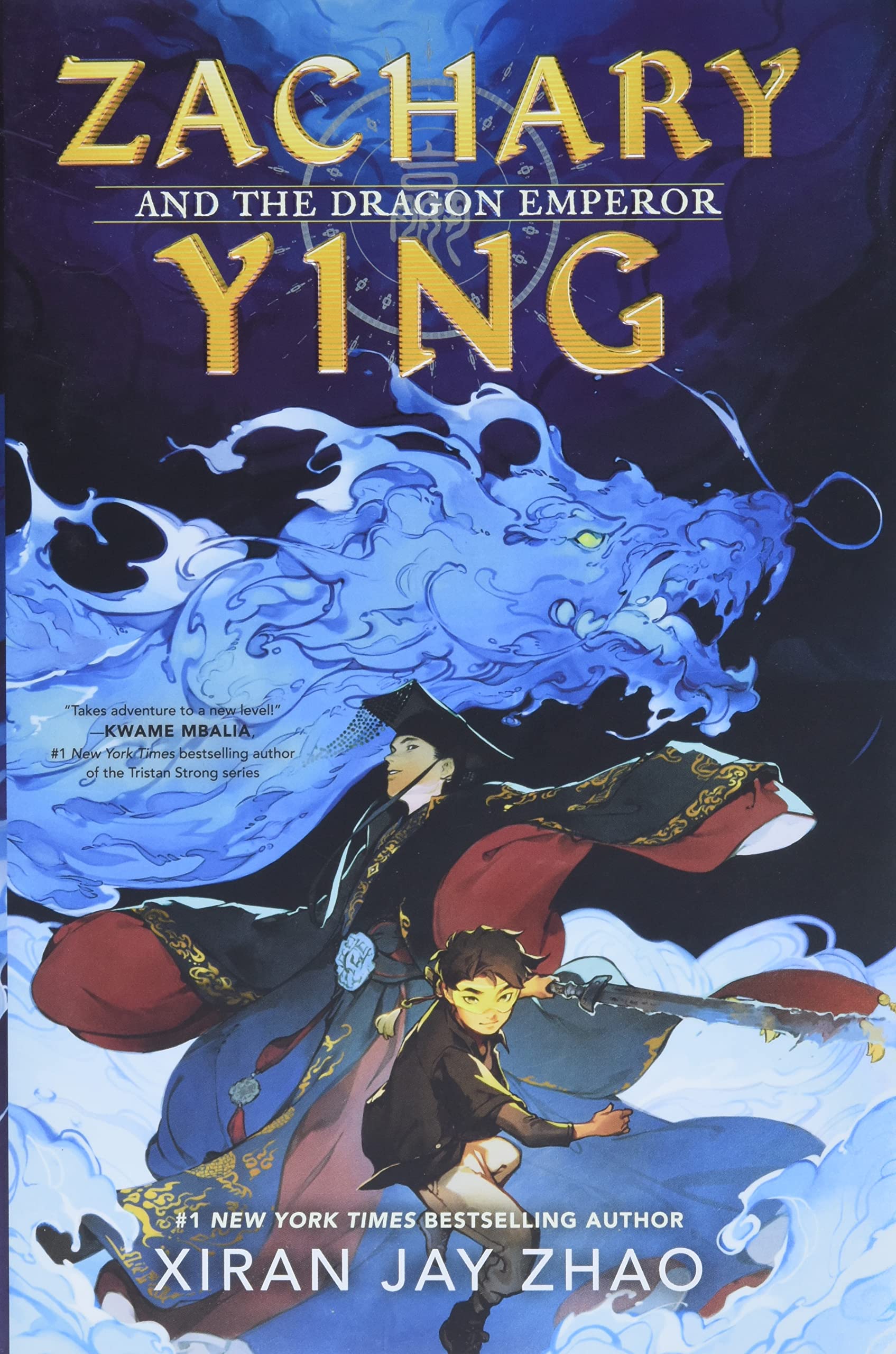
This middle grade story is a beautiful mix of Chinese history, fantasy, mythology, and science fiction technology. It has all the adventure of a Rick Riordan gods & goddesses mythology book, but using the stories of ancient Chinese Emperors and their complex machinations as the myths. These are the stories of China that have been passed down and have been woven into modern Chinese and world culture, including manga & video gaming. The story centers around Zachary Ying, a modern Chinese American kid who loves to play the video game Mythrealm using his special portal goggles. Things go awry when the ancient Chinese emperor Qin Shi Huang, tries to possess Zach, but ends up stuck fused to his portal goggles. They embark on an epic adventure with several others to try to stop the spirits from breaking more completely into our world from the spirit realm. The book is sprinkled with history lessons to help familiarize students with Chinese history they may have never learned – like Zack and me. Water dragons, crazy battles between immortals, and trying to find one’s moral compass make this action-packed adventure worth the read. Those unfamiliar with Chinese names, may mentally destroy & horribly mispronounce some of the names of characters or could find it a stumbling block. It’s worth reading despite that and might be an opportunity to share the audiobook version as a way of learning how to pronounce some of the names. (It helped me!) I think students who love mythology adventures will probably love this addition to the genre. This appears to be a first book in a series as it leaves a major cliffhanger at the end of the book.
Itzel and the Ocelot by Rachel Katstaller
Itzel lives with her nana on the edge of the jungle. Times are hard, because there has been no rain and the seeds her grandmother planted cannot grow without water. Her nana tells her a story about the great snake that brought the rainy season so long ago. But, people no longer believe and the snake retreated to the origin of water. Itzel wants to help her nana and decides to find this snake to bring back the rainy seasons. She enters the jungle and meets up with an ocelot, who agrees to accompany her on her quest. Other animals join along the way, because they too need water. They finally come to the dry riverbed and Itzel realizes that is no giant snake or water. Itzel sits down to play her flute, tears running down her cheeks. Suddenly, something crashes and bangs and the riverbed fills with water. Itzel and the ocelot are carried downriver and their animal companions on the riverbanks return to their homes. Itzel and the ocelot end up back with her nana and watch the rains come down. Her bravery and beliefs brought the rain back.
The story is eloquently told, with additional words in Spanish (word origin is Nawat, and indigenous Salvadoran language. This language is explained (with a glossary) at the back of the book along with an author’s note that gives information about folktales from this culture. Text is accessible and the glossary is helpful for those words that are unfamiliar. Accompanying illustrations are in a folk-art style, which is perfect for this story. Highly recommended.
Another Squiggly Story by Andrew Larson
A young student has a problem. His teacher, Mr. Lopez, assigns the task of writing an autobiography. First of all, what is that? His classmates get right to work. His best friend, Marcus, loves hats and Alia wants to write about vampires, because she thinks about them all the time.
He is stuck! But, his sister comes to the rescue, telling him about her autobiography and reassuring him when he makes mistakes (it’s ok, you can edit). In class, the writing continues, with brainstorming , lists and first proofs. The boy continues his writing journey with a title, cover and more editing. The story ends with an addition to his list of “Things I Want to Be” – an author.
This is a fantastic book for kickstarting the writing process for young students. Appropriate vocabulary and simple illustrations make it a quick read and great discussion starter. I appreciate that the young boy works through his frustration and learns as he goes along. We have all been in that same place in our own writing journey. His friend, Marcus, adapts his autobiography into a comic style piece, noting that “drawing is easier than writing for me”. What a great representation of the reality of writing for so many kids. And, we can infer that the teacher is accepting of this change, since Marcus proudly shows his work-in-progress to the young writer. Use this book to introduce some of the elements of the writing process as well as the concept of autobiographies. Highly Recommended
Let the Monster Out, by Chad Lucas

Having just moved to a new town, Bones Malone is trying to fit in and make new friends and keep his temper in check. This is not easy for Bones, especially since he’s often misunderstood and judged unfairly. Things in this new town get complicated as Bones and then several other new friends start sharing the nightmares of each other. Also, the adults in town start acting like vacant, alien-zombie librarians (AZL). The kids team up to solve the problem and fix the adults in their life from all succumbing to the weird AZLing. To do this, they take on the big corporation that employs many of the town’s adults, but who are definitely up to something shady. The book is a mystery wrapped up in a “Stranger Things” vibe – spooky and suspenseful. Some of the kids’ nightmares are downright scary! The book is full of diverse characters, including Kyle who has autism. I liked that his friends get to experience the way Kyle views the world when they end up in his nightmare. It helps them relate to him better in the real world once they understand how intense sounds, lights, and other stimuli can be for him. Bones is black with a Mom and siblings starting over away from his violent dad. His background has left Bones often feeling the need to protect his Mom and siblings, but also gets him into trouble. Friendship, courage, and facing fears all take center stage in this sometimes scary story. I know this is going to be a hit with students!
Strange Nature: The Insect Portraits of Levon Biss by Gregory Mone
I need to state right here, right now: BUY THIS BOOK!! Insect books for kids are wonderful and can often lead to further exploration. This book can turn anyone into a budding entomologist (and the book explains what that is).
Each two page spread includes a full page photo of an insect with added details and explanations. The second page for each insect includes size, habitat, facts and a sometimes humorous paragraph to bring it more inline with the intellect of a typical 10 year old. The back of the book includes a glossary and a link to the photographer’s website for more incredible insect photos and information.
Photographer Levon Biss went from a backyard foray with his son to an amazing photo exhibit of 37 insects from the Oxford University Museum of Natural History. He called this work “Microsculpture”. Each insect was photographed thousands of times using special equipment and those pictures were combined to make these amazing photographic masterpieces. These photos were originally exhibited as ten foot tall art pieces and now, are in a book that is accessible to young entomologists. This book will not be on the shelf very long – it’s that good! Highly Recommended

